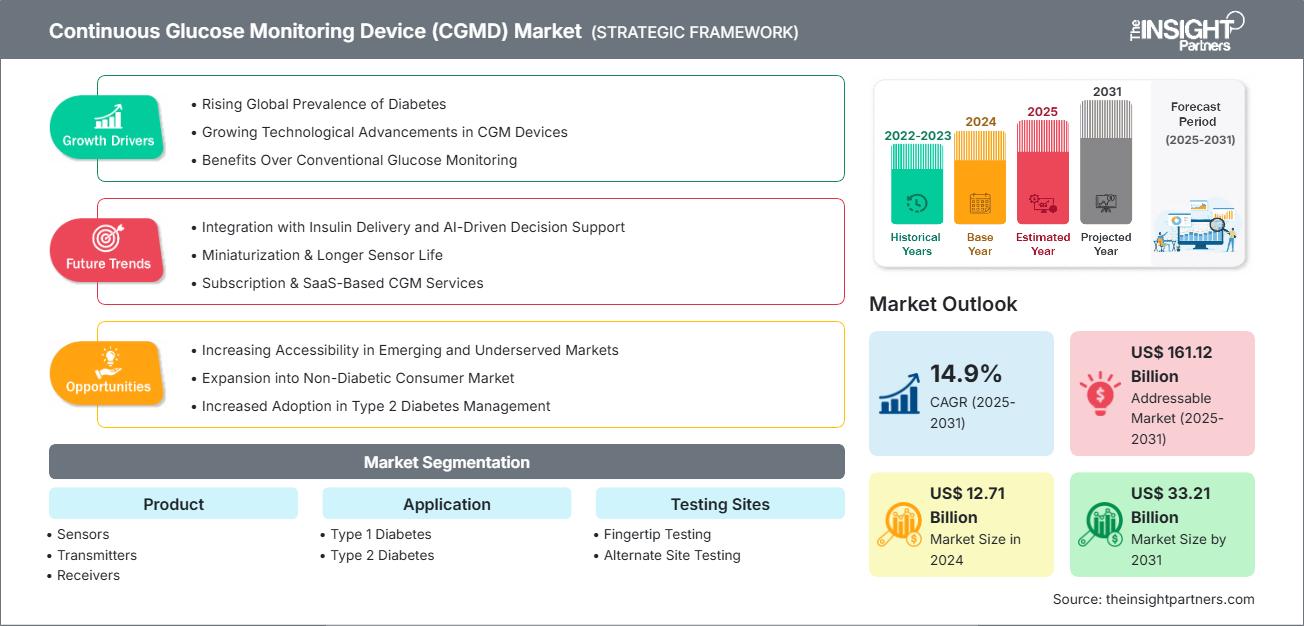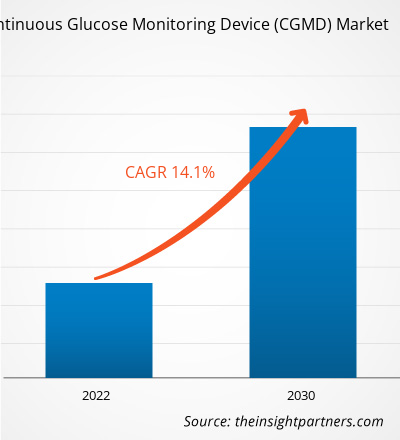连续血糖监测设备 ( CGMD ) 市场规模预计将从 2024 年的 127.1 亿美元增至 2031 年的 332.1 亿美元。预计 2025-2031 年期间该市场的 复合年增长率将达到14.9%。
连续血糖监测设备(CGMD)市场分析
全球糖尿病患病率的上升、连续血糖监测设备 (CGMD)的技术进步以及其优于传统血糖监测的优势,推动了连续血糖监测设备 ( CGMD ) 市场的增长。此外,与胰岛素输送和人工智能支持的整合也促进了市场的增长。新兴市场和服务欠缺市场的日益普及,预计将在未来几年为连续血糖监测设备 ( CGMD ) 市场创造充足的机遇。
连续血糖监测设备(CGMD)市场概览
预计北美将主导连续血糖监测设备(CGMD)市场,在预测期内占据最大份额。此外,由于城市化、久坐的生活方式、饮食变化和技术进步导致患病率不断上升,预计亚太地区在预测期内将出现显著的复合年增长率。中国正面临着严重且不断升级的糖尿病流行,根据 IDF 的数据,预测表明,到2050年,该国将有约 1.68 亿人患有 2 型糖尿病,比 2024 年的数字(1.48 亿)大幅增加。这种激增归因于城市化、饮食变化和人口老龄化。中国政府已设定雄心勃勃的目标,以提高糖尿病意识和管理。到 2030 年,国家卫生健康委员会的目标是在 18 岁及以上人群中实现 60% 的知晓率,并确保 70% 的 2 型糖尿病患者在地方获得标准化管理服务。糖尿病患病率的不断上升刺激了医疗技术的进步,特别是连续血糖监测(CGM)。
为满足日益增长的有效糖尿病管理需求,印度医疗体系在CGM设备的普及和报销方面取得了重大进展。值得注意的是,2022 年 3 月,厚生劳动省( MHLW ) 批准扩大雅培FreeStyle Libre系统的报销范围,将每天至少使用一次胰岛素的所有糖尿病患者纳入其中。同样,2022 年 12 月,泰尔茂株式会社宣布,日本医疗保险系统扩大了Dexcom G6 CGM系统的支付范围,使日本糖尿病患者更容易获得该设备。这些政策变化显著增加了全国范围内CGM设备的采用率。推动这一增长的主要是国内外公司,包括Dexcom、雅培、美敦力和泰尔茂株式会社,它们积极参与在印度开发和分销CGM系统。
您可以免费定制任何报告,包括本报告的部分内容、国家级分析、Excel 数据包,以及为初创企业和大学提供优惠和折扣
连续血糖监测设备(CGMD)市场:战略洞察

- 获取此报告的顶级关键市场趋势。此免费样品将包括数据分析,从市场趋势到估计和预测。
连续血糖监测设备(CGMD)市场驱动因素和机遇CGMD ) 市场驱动力和机遇
市场驱动因素:
全球糖尿病患病率上升:
全球糖尿病患病率的飙升是持续血糖监测 (CGM) 市场增长的根本动力。近期数据显示,糖尿病成人患者比例在过去约三十年中翻了一番,从1990年的约7%上升至2022年的14%,目前全球糖尿病患者已超过8亿。根据国际糖尿病联合会 (International Diabetes Federation) 的数据,目前的患病率约为11.1%(即每九个成年人中就有一人患糖尿病),预计到2050年,患病人数将飙升至8.53亿(每八个成年人中就有一人患糖尿病),增幅达46%。持续血糖监测(CGM)市场。近期数据显示,糖尿病成人患者比例在过去约三十年翻了一番,从1990年的约7%攀升至2022年的14%,目前全球糖尿病患者已超过8亿。根据国际糖尿病联合会 (International Diabetes Federation) 的数据,目前的患病率约为11.1%(即每九个成年人中就有一人患糖尿病),预计到2050年,患病人数将飙升至8.53亿(每八个成年人中就有一人患糖尿病),增幅达46%。
CGM 设备技术不断进步:CGM设备:
持续血糖监测 (CGM) 的技术进步通过提升设备准确性、提升用户体验并拓展潜在用例,推动了市场增长。人工智能驱动的预测算法的集成标志着又一次飞跃。美敦力的 Guardian Sensor 4 等系统可以预测未来 60 分钟的血糖波动,从而实现预警和干预。更广泛的行业趋势表明,机器学习正日益应用于用户特定的血糖趋势建模、个性化警报以及增强与其他健康数据的交互,从而推动 CGM 成为真正具有预测性和个性化的健康工具。持续血糖监测 (CGM ) 通过提升设备准确性、用户体验和拓展潜在用例来推动市场增长。人工智能驱动的预测算法的集成标志着又一次飞跃。美敦力的Guardian Sensor 4 等系统可以预测未来 60 分钟的血糖波动,从而实现预警和干预。更广泛的行业趋势表明,机器学习正越来越多地用于模拟用户特定的血糖趋势、个性化警报以及增强与其他健康数据的交互,从而将CGM推向真正具有预测性和个性化的健康工具。与传统血糖监测相比的优势:
持续血糖监测 (CGM) 消除了频繁指尖采血带来的实际和心理负担,而早期方法的这一局限性影响了患者的依从性和生活质量。儿童尤其青睐这种无需指尖采血的治疗方法,接受强化治疗的患者尽管面临成本和设备复杂性的挑战,但报告显示其治疗满意度和长期设备保留率更高。
市场机会:
提高新兴市场和服务不足市场的可及性:
持续血糖监测 (CGM) 设备市场的一个关键增长机会在于,在新兴和服务欠缺地区,糖尿病患病率正在急剧上升,而这些地区的普及率正在提升。然而,现代糖尿病管理工具的可及性仍然非常有限。然而,在许多地区,CGM 的普及率仍然低于 5%,这主要是由于前期成本高昂、认知度缺乏、报销有限以及医疗基础设施不足。这种差距为寻求扩大覆盖范围的全球和本地企业提供了巨大的未开发机遇。
在新兴经济体扩张:
快速的经济增长推动了中国、印度和南非等国家对医疗基础设施和新医疗技术的投资。加强医疗保健行业的举措包括:实现泌尿科护理现代化、提高早期诊断意识以及扩大医疗保险覆盖范围。市场参与者不断提升的战略举措:
在连续血糖监测设备 (CGMD) 市场运营的公司经常采取战略举措,例如产品批准、合作、资金、协议和新产品发布,以提高销售额、增加地理覆盖范围、扩大客户群并加强市场占有率。公私合作伙伴关系:
公私合作伙伴关系促进政府与私营企业之间的合作,从而改善医疗保健的可及性,为持续血糖监测设备 (CGMD) 市场带来了重大机遇。这些合作伙伴关系可以支持先进 CGM 技术的开发和推广,增加筛查项目的资金投入,并促进培训项目。此类合作不仅促进创新,还能扩大 CGM 解决方案在医疗资源匮乏或偏远地区的覆盖范围。
连续血糖监测设备(CGMD)市场报告细分分析
为了更清晰地了解连续血糖监测设备 (CGMD) 市场运作方式、增长潜力和最新趋势,我们将市场细分为不同的细分市场。以下是大多数行业报告中使用的标准细分方法:
按产品:
传感器:
传感器仍然是糖尿病护理中持续血糖监测 (CGM) 系统的技术和经济基石。这些小型可穿戴组件被植入皮下,用于持续测量间质血糖水平,通常间隔 5 分钟,并将实时数据传输至接收器或智能手机。过去几年,CGM 传感器市场发展势头强劲,这得益于快速创新、全球糖尿病患病率的上升以及 1 型糖尿病患者和日益增多的 2 型糖尿病患者的广泛应用。发射器:
发射器放置在皮肤上,与皮下植入的传感器进行无线通信。该传感器测量间质液中的葡萄糖水平。发射器将数据发送到接收器或智能手机应用程序,使用户能够监测血糖水平并接收高血糖或低血糖警报。CGM 设备通常使用射频发射器,利用无线电波将数据从传感器传输到接收器或智能手机应用程序。近场通信 (NFC) 和蓝牙发射器也用于 CGM 设备。接收者:
接收器,即显示 CGM 传感器血糖读数的设备或接口,是连接感测与用户解读的关键环节。然而,在传感器和发射器的聚光灯下,接收器常常被忽视。最近的技术进步重塑了接收器的功能、格式以及与更广泛的糖尿病护理生态系统的整合。过去,许多 CGM 系统都提供专用的独立接收器。
按应用:
- 1型糖尿病
- 2型糖尿病
按测试站点:
- 指尖测试
- 备用站点测试
按最终用户:
- 医院和诊所
- 自我护理或居家护理
按地域划分:
- 北美
- 欧洲
- 亚太地区
- 拉美
- 中东和非洲
北美持续血糖监测设备 (CGMD) 市场预计将占据相当大的市场份额。全球糖尿病患病率的上升、CGM 设备的技术进步以及市场参与者对传统血糖监测设备优势的追求,共同推动着市场的增长。
连续血糖监测设备(CGMD)市场区域洞察
Insight Partners 的分析师已详尽阐述了预测期内影响连续血糖监测设备 (CGMD) 市场的区域趋势和因素。本节还讨论了北美、欧洲、亚太地区、中东和非洲以及南美和中美洲的连续血糖监测设备 (CGMD) 市场细分和地域分布。
连续血糖监测设备(CGMD)市场报告范围
| 报告属性 | 细节 |
|---|---|
| 2024年的市场规模 | 127.1亿美元 |
| 2031年的市场规模 | 332.1亿美元 |
| 全球复合年增长率(2025-2031) | 14.9% |
| 史料 | 2021-2023 |
| 预测期 | 2025-2031 |
| 涵盖的领域 | 按产品
|
| 覆盖地区和国家 | 北美
|
| 市场领导者和主要公司简介 |
|
连续血糖监测设备(CGMD)市场参与者密度:了解其对业务动态的影响
持续血糖监测设备 (CGMD) 市场正在快速增长,这得益于终端用户需求的不断增长,而这些需求的驱动因素包括消费者偏好的演变、技术进步以及对产品优势的认知度不断提升。随着需求的增长,企业正在扩展产品线,不断创新以满足消费者需求,并抓住新兴趋势,从而进一步推动市场增长。

- 获取连续血糖监测设备(CGMD)市场顶级关键参与者概览
连续血糖监测设备(CGMD)市场份额(按地区)分析
预计未来几年亚太地区将实现最快的增长。拉丁美洲、中东和非洲等新兴市场也为持续血糖监测设备供应商提供了许多尚未开发的扩张机会。
持续血糖监测设备 (CGMD) 市场的增长得益于糖尿病患病率的不断上升、完善的医疗基础设施以及尖端技术的快速普及。以下是各地区市场份额和趋势的总结:
1. 北美
市场份额:
占据全球市场的很大份额关键驱动因素:
- 糖尿病患病率不断上升
- 技术进步
- 有利的监管和报销环境
-
趋势:
跨价值链的人工智能集成。
2.欧洲
市场份额:
由于糖尿病患病率不断上升,占比大幅上升关键驱动因素:
- 糖尿病患病率不断上升
- 加强研发活动
- 欧洲各地推出先进技术
趋势:
设备小型化和智能技术集成
3. 亚太地区
市场份额:
增长最快的地区,市场份额逐年上升关键驱动因素:
- 对智能创新型 CGMD 的需求
- 糖尿病患病率上升
- 在政府加大公共卫生投入的支持下,医疗基础设施得到快速改善。
趋势:
技术进步
4.南美洲和中美洲
市场份额:
市场稳步增长关键驱动因素:
- 糖尿病患病率高
- 不断增长的医疗保健投资和基础设施建设
趋势:
尖端 CGMD 技术的应用日益广泛
5.中东和非洲
市场份额:
虽然规模小,但增长迅速关键驱动因素:
- 扩大医疗基础设施
- 公众意识的提高强调了早期糖尿病诊断的重要性
趋势:
远程医疗和远程设备支持的采用
连续血糖监测设备(CGMD)市场参与者密度:了解其对业务动态的影响
市场密度高,竞争激烈
由于雅培实验室 (Abbott Laboratories)、Dexcom Inc.、Ypsomed Holding AG 等知名企业的存在,竞争十分激烈。A. Menarini Diagnostics srl 和 Medtrum Technologies Inc. 等区域性和利基供应商也加剧了不同地区的竞争格局。
这种激烈的竞争促使公司通过提供以下产品脱颖而出:
- 高级产品
- 定制和可持续解决方案等增值服务
- 有竞争力的定价模式
- 遵守监管准则
机遇与战略举措
- 人们对创新型先进血糖监测设备的日益青睐,推动了对CGMD的需求。便携式、易用的监测设备迎来了创新机遇。
- 公司强调临床研究和监管部门的批准(包括 FDA 对新产品类别的批准),建立强有力的临床证据来支持医院和门诊环境中的采用。
- 企业正瞄准亚太和拉丁美洲高增长、渗透率较低的市场,以扩大规模、建立本地合作伙伴关系并加强培训。亚太地区的制造商正在为新兴市场推出混合且具有价格竞争力的解决方案。
在连续血糖监测设备 (CGMD) 市场运营的主要公司有:
- 雅培实验室
- Dexcom公司
- Ypsomed 控股公司
- 美敦力
- F.霍夫曼-罗氏有限公司
- Senseonics控股公司
- i-SENS公司
- A. Menarini Diagnostics srl
- Tandem 糖尿病护理公司
- Medtrum技术公司
免责声明:以上列出的公司没有按照任何特定顺序排列。
研究过程中分析的其他公司:
- GlySens公司
- Echo Therapeutics公司
- B. Braun SE
- Agamatrix公司
- PHC控股公司
- Nemaura医疗公司
- 浙江普奥科技有限公司
- 微技术医疗
- 三诺生物
- 医疗信托
- 大脚生物医学公司
连续血糖监测设备 (CGMD) 市场新闻和最新发展
Tracky 推出印度首款蓝牙连接连续血糖监测仪
为了应对印度最紧迫的健康挑战之一,总部位于塔那的初创公司 Tracky(DrStore Healthcare Services 旗下的创新健康科技品牌)正式推出了印度首款支持蓝牙的连续血糖监测仪 (CGM)。
FDA 批准 Dexcom G7 15 天连续血糖监测仪
Dexcom宣布其Dexcom G7 15天连续血糖监测系统已获得FDA批准,适用于18岁及以上成年人。该系统可将佩戴时间延长至15.5天。其报告的平均绝对相对差异为8.0%,使其成为目前美国市场上最耐用、性能最高的连续血糖监测设备之一。
连续血糖监测设备(CGMD)市场报告覆盖范围和交付成果
《连续血糖监测设备 (CGMD) 市场规模和预测(2021-2031 年)》报告对以下领域进行了详细的市场分析:
- 持续血糖监测设备 (CGMD) 市场规模以及全球、区域和国家层面涵盖的所有关键细分市场的预测
- 连续血糖监测设备 (CGMD) 市场趋势以及市场动态,例如驱动因素、限制因素和关键机遇
- 详细的 PEST 和 SWOT 分析
- 连续血糖监测设备 (CGMD) 市场分析涵盖主要市场趋势、全球和区域框架、主要参与者、法规和最新市场发展
- 行业格局和竞争分析,涵盖市场集中度、热图分析、知名参与者以及连续血糖监测设备 (CGMD) 市场的最新发展
- 详细的公司简介
- 历史分析(2 年)、基准年、预测(7 年)及复合年增长率
- PEST和SWOT分析
- 市场规模、价值/数量 - 全球、区域、国家
- 行业和竞争格局
- Excel 数据集
近期报告
客户评价
购买理由
- 明智的决策
- 了解市场动态
- 竞争分析
- 客户洞察
- 市场预测
- 风险规避
- 战略规划
- 投资论证
- 识别新兴市场
- 优化营销策略
- 提升运营效率
- 顺应监管趋势




















 获取免费样品 - 连续血糖监测设备(CGMD)市场
获取免费样品 - 连续血糖监测设备(CGMD)市场